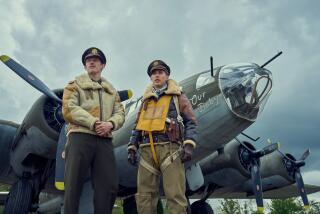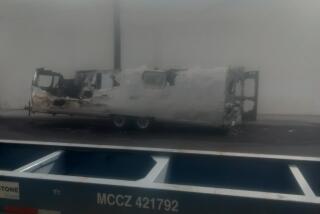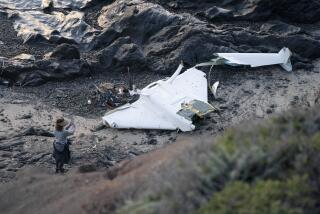Daredevil pilots belly-flopped into the record books — and the hearts of Washington town
The Wright brothers. Charles Lindbergh. Amelia Earhart. Howard Hughes.
You don’t have to be interested in aviation to recognize the names of famous, risk-taking pilots from the early days of flight.
But mention Clyde Pangborn and Hugh Herndon, and most folks stare blankly as they utter, “Who?”
Even in the Wenatchee Valley, east of the Cascades in central Washington, schoolchildren don’t know the names, although this is where history was made on Oct. 5, 1931, when the two pilots, in a plane named Miss Veedol (after a brand of motor oil), belly-flopped onto a muddy airstrip, becoming the first people to fly nonstop across the Pacific.
The two, who had taken off 41 hours earlier from Japan, flew much farther than “Lucky Lindy” had four years earlier, when his Spirit of St. Louis crossed the Atlantic. Unlike Lindbergh, Pangborn and Herndon didn’t make it into most history books — or even the movies.
“I’m mystified by why it hasn’t received the press that it should have, because it was such a milestone,” said Dave Stadler, one of several pilots who run the Spirit of Wenatchee, a nonprofit that works to keep alive the accomplishments of Pangborn and Herndon. They display a functioning replica of Miss Veedol at air shows around the country, including the Wings & Wheels Festival held each October in East Wenatchee.
The festival ground is just one of several area venues where the two daredevils are remembered. Monuments can be found in local parks. At one, a 6-foot model of the bright-red aircraft spins atop a pole. At another, a tall stone sculpture — topped with two birds, their wings outstretched — marks the location of the muddy landing strip.
But it’s at the Wenatchee Valley Museum and Cultural Center that their remarkable and relatively untold story is most fully explored.
A fascinating exhibit focuses on Pangborn, a Washington native familiar with the community’s dirt runway because his mother and brother lived in Wenatchee.
“He had flown in and out of Wenatchee several times,” said Mark Behler, the museum’s curator. By 1931, Pangborn, a former stunt pilot, had joined with Herndon to operate a three-plane airline.
A showpiece of the museum is Miss Veedol’s original propeller, badly bent on one end from the rough landing. It, a pack of Herndon’s Camel cigarettes and Pangborn’s white silk scarf are among other popular artifacts.
The propeller is the only part of Miss Veedol that remains. The plane, with a new propeller, later disappeared over the Atlantic with another crew at the controls.
“Not even the Smithsonian has a piece of it,” Behler said.
The curator said Pangborn and Herndon had only a Thermos of hot tea and some chicken for nourishment during the grueling flight.
“They had no heater. They had no radio, not even any life jackets,” Behler said. “It really was by the seat of their pants.”
Stadler called the feat a “fantastic accomplishment” by two young men who “were willing to take risks.” Part of their incentive was the $25,000 prize a Japanese newspaper had offered to whomever first made it across the Pacific without stopping.
“They took off with an overloaded airplane that they didn’t really know would get off the ground,” Stadler said. “It was one of those ‘chew your knuckle’-type things, whether they were going to get off or not. They were bound and determined, because if they didn’t get off, there was going to be a big inferno … and instant death.”
Stadler added that the city of Seattle — already a hub for aviators — was offering additional prize money if the first flight landed there, but that was impossible.
“Seattle was totally socked in [by fog] all the way up to the high Cascades,” he recalled. The rough landing in Wenatchee was anticipated; to lighten the load, the plane’s landing gear, along with empty fuel cans, had been ditched over the Pacific.
Wenatchee’s Pangborn Memorial Airport honors the man who made history at the controls of a Bellanca plane with an old-fashioned compass and an artificial horizon — in 1931, a new contraption — as its only instruments.
The replica plane, built a few years ago with donated funds, is hangared at Pangborn. Once enough money is raised, the Spirit of Wenatchee group plans to install large windows through which the new Miss Veedol can be viewed and information panels read, helping to give the plane and its remarkable pilots their due, eight decades late.
“I guess it was just a sign of the times,” Stadler mused. “We were in the middle of a depression here in 1931, and people’s minds were on different things.
“Maybe it was landing in Wenatchee, a small community,” he added. “If they had landed in New York or Los Angeles or somewhere like that, [maybe] it would have been much more newsworthy and spectacular.”
More to Read
Sign up for The Wild
We’ll help you find the best places to hike, bike and run, as well as the perfect silent spots for meditation and yoga.
You may occasionally receive promotional content from the Los Angeles Times.






